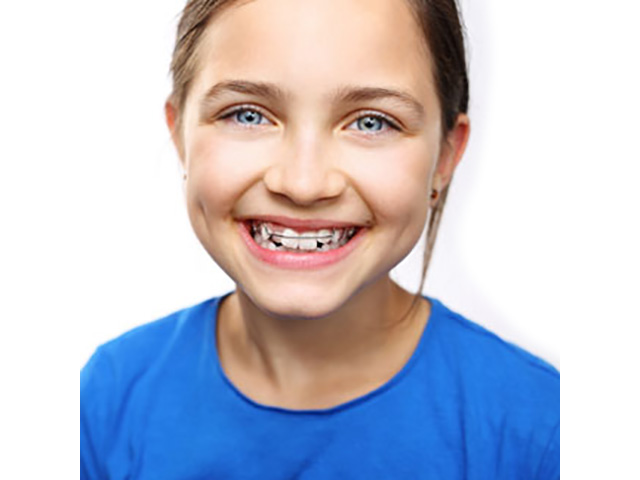[dropcap type=”background”]F[/dropcap]inally, you or your child are finishing orthodontic treatment. It’s been a long, hard road to achieving straight teeth and a beautiful smile! While dental veneers may be more popular than orthodontic treatment, many people still go down this route. Yet just when you think your orthodontic journey is over, your orthodontist tells you that it’s time for the next phase of your treatment- retainers. Don’t dismay, though, because retainers are a surefire way of assuring that your hard work and sacrifice with braces or Invisalign ® was not in vain and your beautiful new smile will be maintained for a lifetime. Here are some common questions and answers regarding orthodontic retainers.
What are retainers?
Retainers are appliances generally used to retain teeth, or maintain their position, following active orthodontic treatment. A mold, or impression is taken of a patient’s teeth, which is used for custom fabrication of the retainer by the orthodontist or an orthodontic lab.
Why are retainers necessary?
Following orthodontic tooth movement, teeth are not yet entirely stabilized in their new position, as it takes time for the bone and ligaments surrounding the teeth to retighten and hold them securely in place. If retainers are not worn as prescribed, the teeth can tend to drift out of alignment and the beautiful treatment results can be compromised.
What types of retainers are there?
There are two types of orthodontic retainers: attached braces (or ติดเครื่à¸à¸‡à¸¡à¸·à¸à¸ˆà¸±à¸”ฟัน) and removable. Choosing the type usually involves the clinical needs of the individual case, the desires of the patient and the overall compliance that the orthodontist and patient can expect from retainer maintenance. The fixed type of retainer is a thin wire bonded along the back of the lower (and sometimes upper) front teeth. The advantage of the fixed retainer is that the patient does not have to worry about putting it on and off or losing it. Removable retainers come in two basic varieties. The first is the traditional “Hawley” retainer, which is a combination of a wire going across the front of the front teeth held in place with a combination of acrylic material and hooks (or clasps) on the back teeth. These retainers are an excellent option following orthodontic treatment as they allow teeth to “settle” into place and also are adjustable by the orthodontist in case a tooth is tending to shift. The second removable variety is the clear or “Essix” retainer. These are the more esthetic of the two removable retainer options since they are totally clear and a good choice following Invisalign ® treatment.
What maintenance is required with retainers?
Removable retainers require proper hygiene, as they collect plaque and bacteria just like teeth do. Retainers must be removed from the mouth and brushed with liquid soap and cold water 3 times daily to keep them clean. Never use hot water on retainers or leave them in your car, as the heat can damage or warp the material. It is also essential to keep retainers safely in the retainer case provided by your orthodontist so they don’t get broken or lost. And always keep them away from pets, especially dogs; a retainer can quickly become a very expensive puppy chew toy!
Fixed retainers require the daily use of floss threaders to keep the gums healthy as well as great brushing in the area. Frequent dental visits are also recommended to clean the tartar that can tend to build up around the permanent retainer.
How long do retainers last?
The lifetime of a retainer varies greatly depending on the habits of and maintenance by the patient. Removable retainers can last many years if they are well taken care of. Fixed retainers also can last many years if hygiene is maintained and a patient is careful with his/her diet.
How long are retainers needed after orthodontic treatment?
In my practice I recommend that patients wear their retainers full time (day and night) for the first 6 months following active orthodontic treatment and then every night for as long as possible. Since our teeth can tend to shift at any time, the longer one wears their retainers, the more likely they are to maintain their perfect smile.
I have had so many patients over the years that have come to me seeking retreatment, confiding that they did not wear their retainers the first time around and their teeth shifted. So I urge my patients, very simply- wear your retainers! After all of the time and money invested to achieve perfectly straight teeth, we want to keep them that way. Excellent retainer wear following orthodontic treatment will ensure a beautiful, healthy smile for a lifetime!
Dr. Rothman is the owner and orthodontist at Pinecrest Orthodontics, located in the Dixie Belle Shops at 12197 S. Dixie Highway in Pinecrest, FL. PH: 305.423.4130 pinecrestortho.com. Please email Dr. Rothman with your orthodontic questions at drrothman@pinecrestortho.com.





 Deering Estate
Deering Estate
 Massage Envy South Miami
Massage Envy South Miami
 Calla Blow Dry
Calla Blow Dry
 My Derma Clinic
My Derma Clinic
 Sushi Maki
Sushi Maki
 Sports Grill
Sports Grill
 The Healthy Kitchen
The Healthy Kitchen
 Golden Rule Seafood
Golden Rule Seafood
 Malanga Cuban Café
Malanga Cuban Café

 Kathleen Ballard
Kathleen Ballard
 Panter, Panter & Sampedro
Panter, Panter & Sampedro
 Vintage Liquors
Vintage Liquors
 The Dog from Ipanema
The Dog from Ipanema
 Rubinstein Family Chiropractic
Rubinstein Family Chiropractic
 Your Pet’s Best
Your Pet’s Best
 Indigo Republic
Indigo Republic




 ATR Luxury Homes
ATR Luxury Homes


 2112 Design Studio
2112 Design Studio
 Hamilton Fox & Company
Hamilton Fox & Company
 Creative Design Services
Creative Design Services
 Best Pest Professionals
Best Pest Professionals
 HD Tree Services
HD Tree Services
 Trinity Air Conditioning Company
Trinity Air Conditioning Company
 Cisca Construction & Development
Cisca Construction & Development
 Mosquito Joe
Mosquito Joe
 Cutler Bay Solar Solutions
Cutler Bay Solar Solutions


 Miami Royal Ballet & Dance
Miami Royal Ballet & Dance
 Christopher Columbus
Christopher Columbus
 Pineview Preschools
Pineview Preschools
 Westminster
Westminster
 Carrollton
Carrollton
 Lil’ Jungle
Lil’ Jungle
 Frost Science Museum
Frost Science Museum
 Palmer Trinity School
Palmer Trinity School
 South Florida Music
South Florida Music
 Pinecrest Orthodontics
Pinecrest Orthodontics
 Dr. Bob Pediatric Dentist
Dr. Bob Pediatric Dentist
 d.pediatrics
d.pediatrics
 South Miami Women’s Health
South Miami Women’s Health

 The Spot Barbershop
The Spot Barbershop
 My Derma Clinic
My Derma Clinic




 Miami Dance Project
Miami Dance Project

 Rubinstein Family Chiropractic
Rubinstein Family Chiropractic
 Indigo Republic
Indigo Republic

 Safes Universe
Safes Universe
 Vintage Liquors
Vintage Liquors
 Evenings Delight
Evenings Delight





 Atchana’s Homegrown Thai
Atchana’s Homegrown Thai
 Baptist Health South Florida
Baptist Health South Florida

 Laser Eye Center of Miami
Laser Eye Center of Miami
 Visiting Angels
Visiting Angels
 OpusCare of South Florida
OpusCare of South Florida

 Your Pet’s Best
Your Pet’s Best





 HD Tree Services
HD Tree Services
 Hamilton Fox & Company
Hamilton Fox & Company


 Creative Design Services
Creative Design Services